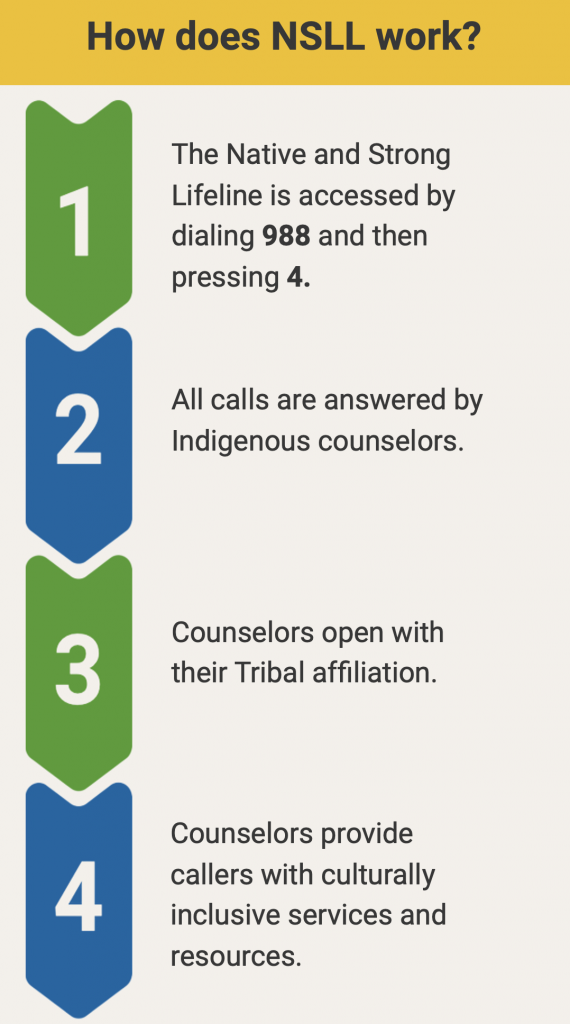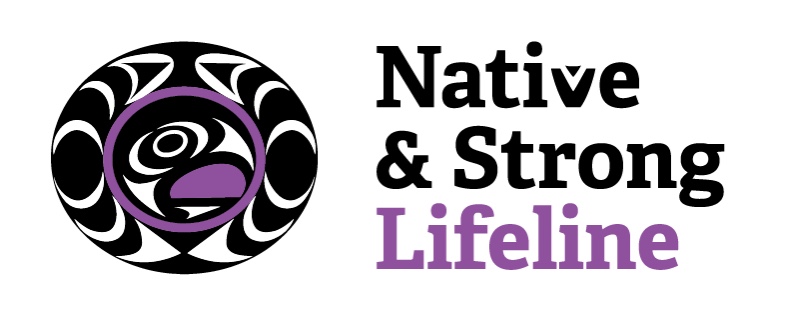Native and Strong Lifeline: The Nation’s First 988 Crisis Line for Indigenous People
November 15, 2023
Background
The Native and Strong Lifeline (NSLL) is the nation’s first 988 crisis line designed by and for Indigenous people in Washington state. Operated by the Volunteers of America Western Washington (VOAWW), NSLL has received over 4,150 calls since its launch in November 2022.
NSLL came about through community-based efforts. In 2021, the Washington state legislature passed House Bill 1477, which carved out resources for NSLL from the state’s 988 funding. VOAWW staff then went door to door and sent surveys to local Indigenous communities, as well as those who serve these communities, to assess their needs, strengths, and challenges in accessing crisis services. This feedback informed the design of NSLL and the curriculum that VOAWW developed to train counselors. One of the people who led that effort was Mia Klick, who is now the NSLL coordinator. “These communities that we help today with the lifeline are the ones that I saw when I was a child that needed help,” said Klick. “This program helps them better than I could’ve thought.”
Purpose
NSLL was created to address disproportionate rates of suicide among Indigenous populations. In 2020, the state suicide rate among non-Hispanic American Indian and Alaska Native people was 34 percent higher than among the general population.1 NSLL also fills a gap by providing culturally informed crisis services and resources that respond to the unique needs of Indigenous people.
According to VOAWW Director of Tribal Services Rochelle Hamilton, the service was originally developed “to break down barriers to really get to the heart of trauma-informed care.” Hamilton said the program’s goals reach beyond helping local communities. “We don’t want it to stop in Washington; we want other people to replicate it and we hope one day to be helping people across the country.”
How It Works
NSLL is open 24 hours a day, 7 days a week, 365 days a year, providing support to any Indigenous person in crisis, regardless of Tribal-enrollment status. NSLL serves any Tribally-affiliated person calling with a Washington area code, including those whose Tribes are headquartered in other states or countries. Even out-of-state callers receive help and referrals to crisis resources in their area. NSLL also serves family members of those in crisis, social workers, health care providers, and other concerned individuals.
NSLL counselors start each interaction by sharing their Tribal affiliation, which helps them connect with callers. And once a call has ended, NSLL coordinates with VOAWW’s Native Resource Hub to follow up with callers and help them access additional services. A centralized phone line and information center in Washington state that connects Indigenous communities with a variety of resources and services, the Native Resource Hub is well-positioned to help NSLL callers access ongoing support.
All NSLL staff are members of Indigenous populations and their lived experience expertise is crucial to the project’s success. Unlike some other crisis lines, NSLL counselors are not required to have a specific academic degree. According to NSLL leadership, many members of Indigenous communities don’t have the same educational opportunities as other groups, but they do bring essential lived experience expertise to the work. Hamilton says callers “are looking for people who represent them” and “are more comfortable speaking with our counselors than those at other lifelines.” In addition to standard crisis counseling training, all NSLL counselors also receive intensive culturally specific training and learn how to incorporate traditional healing methods into crisis counseling.

How It’s Going
Since its launch one year ago, NSLL has shown success in meeting the needs of callers, as well as retaining and expanding its staff. The average call wait time is just 16 seconds and 90.25% of calls are answered in under 30 seconds. While it started out a year ago with 11 counselors, NSLL now has 23.
Both callers and counselors have experienced the benefits of NSLL. According to Klick, NSLL counselors find it “extremely healing . . . to know that their journey has come full circle. They get to help people now and that is the best thing because many of them came from a place in the past where they needed help.”
NSLL has faced some challenges, including concerns that, as a service with government funding, it would draw attention and resources away from Tribally-based programs. Hamilton made it clear, however, that NSLL is “not here to replace any Tribal services, we just want to be there if needed. We can be a backup support to any [Indigenous people in crisis].”
When asked about NSLL’s success, Klick said, “To be totally honest, we weren’t sure how it was going to go, as we all know that our relatives are private people and sharing their stories takes great strength. However, . . . over the course of the last year . . . our Native communities have used this line for everything from [addressing suicidal ideation], to needing to bend an ear, all the way to our relatives calling to celebrate that THAT day, they were able to stay clean and sober. This line has become so much more than we ever could have imagined.”



Additional Resources
- Check out and share the NSLL website.
- Read about Washington State House Bill 1477, which funded NSLL.
- Listen to a podcast episode that discusses the motivation for establishing NSLL.
- Learn more about centering lived experience and culturally competent approaches in prevention efforts.
References
- Washington State Department of Health. (2022, November 17). Nation’s first Native and Strong Lifeline launches as part of 988. https://doh.wa.gov/newsroom/nations-first-native-and-strong-lifeline-launches-part-988
